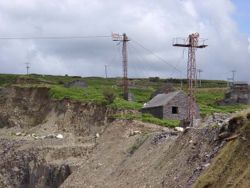
Blondin (quarry equipment)
Encyclopedia

Aerial tramway
An aerial tramway , cable car , ropeway or aerial tram is a type of aerial lift which uses one or two stationary ropes for support while a third moving rope provides propulsion...
employed in open pits in the slate quarries
Slate industry
The slate industry is the industry related to the extraction and processing of slate. Slate is either quarried from a slate quarry or reached by tunneling in a slate mine. Common uses for slate include as a roofing material, a flooring material, gravestones and memorial tablets, and for electrical...
in Wales
Wales
Wales is a country that is part of the United Kingdom and the island of Great Britain, bordered by England to its east and the Atlantic Ocean and Irish Sea to its west. It has a population of three million, and a total area of 20,779 km²...
to transport wagons loads of rock between locations. They were named after the famous tightrope walker Charles Blondin
Charles Blondin
Jean François Gravelet-Blondin was a French tightrope walker and acrobat.-Life:Blondin was born on 24 February 1824 at St Omer, Pas-de-Calais, France. His real name was Jean-François Gravelet, and he was known also by the names Charles Blondin or Jean-François Blondin, or more simply "The Great...
.
History
The first known use of Blondins in the quarry industry was at Penrhyn QuarryPenrhyn Quarry
The Penrhyn Slate Quarry is a slate quarry located near Bethesda in north Wales. At the end of the nineteenth century it was the world's largest slate quarry; the main pit is nearly long and deep, and it was worked by nearly 3,000 quarrymen. It has since been superseded in size by slate quarries...
where they were installed by 1913. Penrhyn quarry was based around a single large pit over 400 feet deep, worked as a series of terraces. A variety of means were used to transport slate from the terraces to the mills where the rock was processed. The quarry already had an extensive internal narrow gauge
Narrow gauge
A narrow gauge railway is a railway that has a track gauge narrower than the of standard gauge railways. Most existing narrow gauge railways have gauges of between and .- Overview :...
railway system in place and many terraces were connected via inclines
Cable railway
A cable railway is a steeply graded railway that uses a cable or rope to haul trains.-Introduction:...
. Blondins were developed to connect more remote terraces directly to the mills - they were distinguished by the fact that rock was transported on the ropeways in railway wagons slung from cradles. The ropeways ran horizontally or nearly horizontally until the cradle hit a stop, at which point the wagons were automatically lowered to ground level where they were moved by rail to the point of loading or unloading.
Other nearby quarries also adopted Blondins, notably those in the Nantlle Valley
Nantlle Valley
The Nantlle Valley is an area in Gwynedd, north Wales, characterised by its large number of small settlements.Around 80% of the population of the Nantlle Valley speak Welsh as their first language. Some of the communities came into being as a result of slate quarrying in the late eighteenth or...
.

